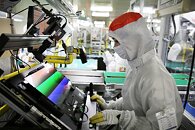- Joined
- Oct 9, 2007
- Messages
- 47,528 (7.48/day)
- Location
- Hyderabad, India
| System Name | RBMK-1000 |
|---|---|
| Processor | AMD Ryzen 7 5700G |
| Motherboard | ASUS ROG Strix B450-E Gaming |
| Cooling | DeepCool Gammax L240 V2 |
| Memory | 2x 8GB G.Skill Sniper X |
| Video Card(s) | Palit GeForce RTX 2080 SUPER GameRock |
| Storage | Western Digital Black NVMe 512GB |
| Display(s) | BenQ 1440p 60 Hz 27-inch |
| Case | Corsair Carbide 100R |
| Audio Device(s) | ASUS SupremeFX S1220A |
| Power Supply | Cooler Master MWE Gold 650W |
| Mouse | ASUS ROG Strix Impact |
| Keyboard | Gamdias Hermes E2 |
| Software | Windows 11 Pro |
While most laptops and notebooks now offer a 60 Hz refresh rate, Samsung Display announced today that it will mass produce the world's first 90 Hz OLED laptops in the first quarter of this year. Samsung Display Chief Executive Officer Joo Sun Choi said that the company will initially produce very large quantities of 14-inch, 90 Hz OLED displays destined for laptops and notebooks, beginning in March.
"OLED display panels can best satisfy the diverse consumer needs for laptops used in telework, online education, video streaming, and gaming," the company said. Samsung Display said it is helping to introduce a major shift in the market as it collaborates closely with global manufacturers to achieve a new level of excellence for refresh rates in laptops, beginning this year.

Samsung Display believes consumers will quickly warm to the opportunity to purchase OLED displays offering a 90 Hz refresh rate, even though the OLED panels require the use of a high-spec. graphics card. In rendering static images 90 times a second, they will make movements look much more lifelike, or snappier, from a color perspective. As such, the new refresh rate updates changes in motion more often, allowing for smoother-looking visuals that appear virtually seamless to the viewer.
In a seeming contradiction, OLED displays are able to transition from one screen to the next much more quickly than LCD screens with the same refresh rate. As a result, OLED screens can make gaming and movie watching a more vibrant, pleasurable experience, without compromise. Their 90 Hz OLED refresh rate is actually 10X the fastest screen response time on the market today. In fact, the 90 Hz OLED display offers high-speed driving that is actually on par with that of 120 Hz LCD screens.
Samsung Display tested blur length using the same motion picture of a fast driving car and found that the image drag of 90 Hz OLED and 120 Hz high refresh rate LCD screens is 0.9 mm and 1 mm, respectively. In short, 90Hz OLED screens smear amazingly little, at practically the same rate as a 120 Hz LCD.
View at TechPowerUp Main Site
"OLED display panels can best satisfy the diverse consumer needs for laptops used in telework, online education, video streaming, and gaming," the company said. Samsung Display said it is helping to introduce a major shift in the market as it collaborates closely with global manufacturers to achieve a new level of excellence for refresh rates in laptops, beginning this year.

Samsung Display believes consumers will quickly warm to the opportunity to purchase OLED displays offering a 90 Hz refresh rate, even though the OLED panels require the use of a high-spec. graphics card. In rendering static images 90 times a second, they will make movements look much more lifelike, or snappier, from a color perspective. As such, the new refresh rate updates changes in motion more often, allowing for smoother-looking visuals that appear virtually seamless to the viewer.
In a seeming contradiction, OLED displays are able to transition from one screen to the next much more quickly than LCD screens with the same refresh rate. As a result, OLED screens can make gaming and movie watching a more vibrant, pleasurable experience, without compromise. Their 90 Hz OLED refresh rate is actually 10X the fastest screen response time on the market today. In fact, the 90 Hz OLED display offers high-speed driving that is actually on par with that of 120 Hz LCD screens.
Samsung Display tested blur length using the same motion picture of a fast driving car and found that the image drag of 90 Hz OLED and 120 Hz high refresh rate LCD screens is 0.9 mm and 1 mm, respectively. In short, 90Hz OLED screens smear amazingly little, at practically the same rate as a 120 Hz LCD.
View at TechPowerUp Main Site




